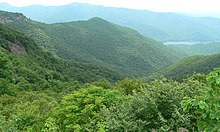

The following is a list of subranges within the Appalachian Mountains, a mountain range stretching ~2,050 miles from Newfoundland and Labrador, Canada to Alabama, US. The Appalachians, at their initial formation, were a part of the larger Central Pangean Mountains along with the Scottish Highlands, the Ouachita Mountains, and the Anti-Atlas Mountains. The modern ranges were formed and/or deformed by the Acadian, Caledonian, Alleghenian, Mauritanide and Variscan orogenies with the Alleghenian orogeny being the most notable to the modern Appalachians.[1][2][3]
The Appalachians are also subdivided by a number of large plateaus and additional subplateus. These are commonly not considered subranges although they do contain some features referred to as mountains which are assigned to both their geographic "range" and the more general Appalachian Mountains. These plateaus, such as the Allegheny Plateau, are considered provinces of the Appalachian Highlands and the mountains assigned to them are instead considered pieces of dissected plateaus.[4]
Additionally, subranges and ridges of subranges (Such as the Yew Mountains) are inconsistently related to the Appalachian Mountain Range. No clear distinction exists as to what units qualify as directly related subranges of the Appalachians until the level of mountain.[5] As such, the distinction is often arbitrary and based on person preference by the geographer or geologist publishing material. This has led to the distinction being largely unrelated to area, geological features, or topography.[6] This list is more comprehensive to account for that variation and includes the parent range of each subrange noted. This list includes physiographic regions, for information of the physiographic regions, provinces, and sections: refer to the Appalachian Highlands page for American sections and the Appalachian Uplands page for Canadian sections.
Due to the lack of solid distinctions in the requirements of an area to be a range, this list includes most physiographic divisions, many larger ridges, plateaus, mountain complexes, most stratigraphic ridges, certain lowlands and uplands, local highlands, and certain other types of geographic and geological features. This list is not a comprehensive list of every peak and summit of the Appalachians, individual mountains, when included, are generally individual politically but not geographically, and each inclusion must meet the set of criteria used to define a subrange.
- ^ Bartholomew, M.J.; Whitaker, A.E. (2010). "The Alleghanian deformational sequence at the foreland junction of the Central and Southern Appalachians". In Tollo, R.P.; Bartholomew, M.J.; Hibbard, J.P.; Karabinos, P.M. (eds.). From Rodinia to Pangea: The Lithotectonic Record of the Appalachian Region, GSA Memoir 206. pp. 431–454. ISBN 978-0-8137-1206-2 Retrieved August 24, 2021.
- ^ Hatcher, R.D. "Tracking lower-to-mid-to-upper crustal deformation processes through time and space through three Paleozoic orogenies in the Southern Appalachians using dated metamorphic assemblages and faults". Geological Society of America Abstracts with Programs. Geological Society of America. Archived from the original on 2018-08-06. Retrieved January 23, 2012.
- ^ Gouvernement du Canada, Ressources naturelles Canada. "Noms de lieux – Recherche par nom de toponyme". toponymes.rncan.gc.ca. Retrieved January 3, 2024.
- ^ "Physiographic divisions of the conterminous U. S. – ScienceBase-Catalog". water.usgs.gov. Retrieved October 10, 2023.
- ^ "Appalachian Mountains". WorldAtlas. July 19, 2021. Retrieved January 3, 2024.
- ^ Nevin Melancthon Fenneman (1938). "Physiography of eastern United States". Internet Archive. McGraw-Hill Book Company, inc. p. 121.
© MMXXIII Rich X Search. We shall prevail. All rights reserved. Rich X Search
